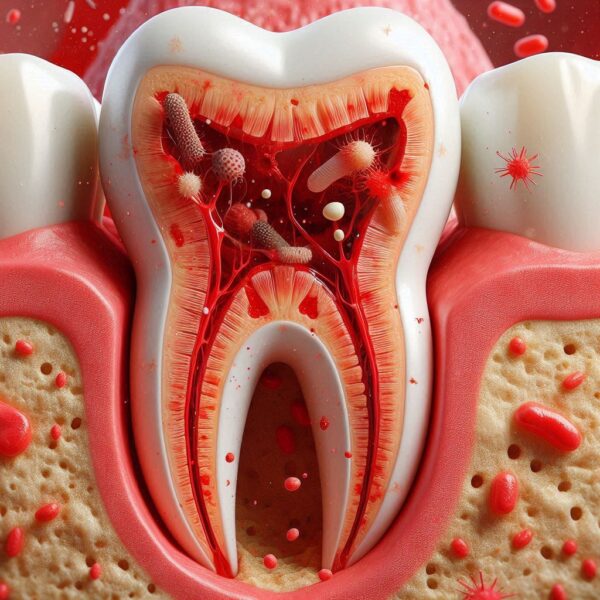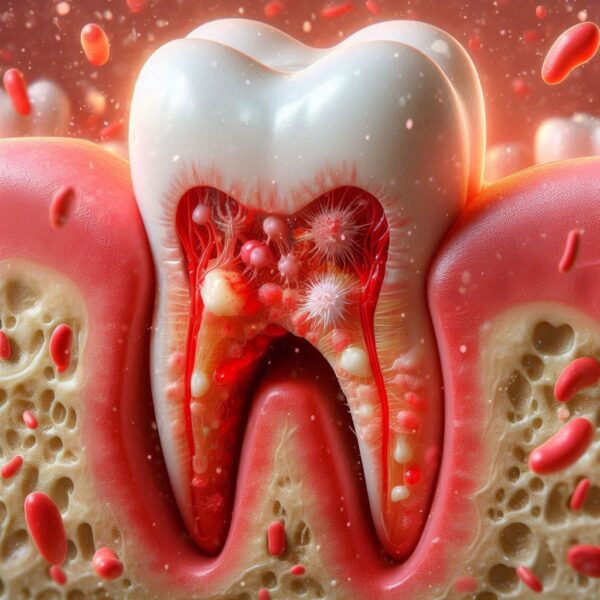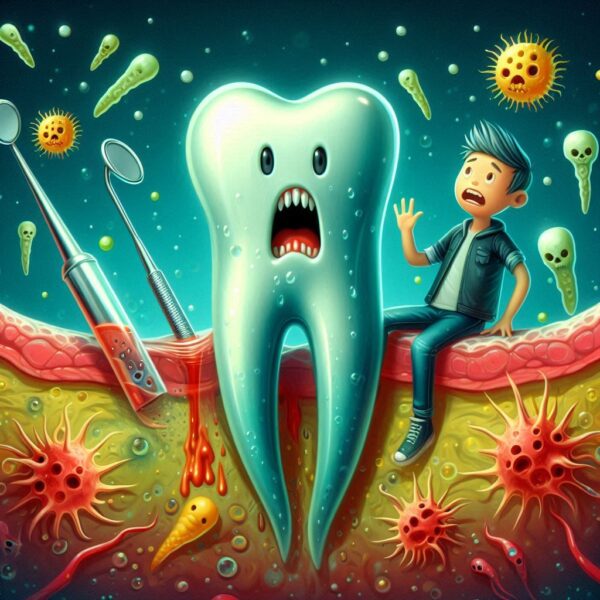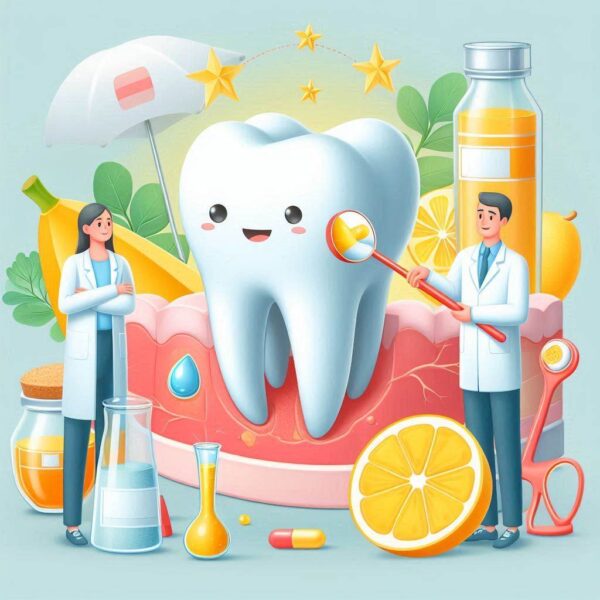
An infected root canal can be a serious dental issue that requires prompt attention. Root canals become infected when bacteria invade the dental pulp, the innermost part of the tooth, often as a result of untreated cavities, fractures, or previous dental procedures.
This infection can cause a range of symptoms, from mild discomfort to severe pain, and if left untreated, it can lead to more serious health complications.
Understanding the symptoms of an infected root canal is crucial for seeking timely treatment and preserving overall dental health.
Infected Root Canal Symptoms

A root canal infection occurs when the soft tissue inside the tooth, known as the pulp, becomes inflamed or infected. This can happen due to deep decay, repeated dental procedures on the tooth, or a crack or chip in the tooth.
Even a traumatic injury to a tooth may cause pulp damage without visible cracks. Once the pulp is infected, it can lead to a range of symptoms that may indicate the need for a root canal treatment.
Symptoms of an Infected Root Canal
Persistent Pain
One of the most common symptoms of an infected root canal is persistent pain. This pain may be constant or intermittent and can vary in intensity. It often worsens when chewing or applying pressure to the tooth. The pain may also radiate to other areas of the face, such as the jaw, ear, or even the neck.
Sensitivity to Temperature
Increased sensitivity to hot and cold foods and beverages is another sign of a possible root canal infection. This sensitivity may linger long after the hot or cold stimulus has been removed and can be a sign that the infection has reached the nerves inside the tooth.
Swelling and Tenderness
Swelling around the affected tooth, gums, and even the face can occur with a root canal infection. The gums may feel tender or appear red and inflamed. In severe cases, swelling can extend to the neck or other areas of the face.
Discoloration of the Tooth
An infected tooth may become discolored, often turning a darker shade compared to the surrounding teeth. This discoloration occurs because the infection affects the blood supply to the tooth’s pulp.
Pus Drainage
The presence of pus or an abscess in the area around the tooth is a clear indicator of infection. This can lead to a foul taste in the mouth or bad breath. The abscess may cause significant pain and should be treated immediately to prevent the spread of infection.
Loose Tooth
As the infection progresses, it can weaken the tooth and surrounding structures, causing the tooth to feel loose. This mobility is a serious symptom and requires prompt dental intervention.
Complications of an Untreated Root Canal Infection
If left untreated, a root canal infection can lead to severe complications. The infection can spread to the surrounding tissues, including the jawbone and other parts of the body.
This can result in the formation of an abscess, a pus-filled pocket that can cause significant pain and swelling. In rare cases, the infection can spread to vital organs, leading to systemic health issues such as sepsis.
Treatment Options
Root Canal Procedure
Treatment for an infected root canal typically involves a root canal procedure. During this procedure, the infected pulp is removed, and the inside of the tooth is cleaned and sealed to prevent further infection.
Antibiotics
In some cases, antibiotics may be prescribed to help eliminate the infection.
Tooth Extraction
If the tooth is too damaged to be saved, it may need to be extracted.
Prevention
Good Oral Hygiene
Preventing root canal infections involves maintaining good oral hygiene practices. Regular brushing and flossing, along with routine dental check-ups, can help prevent cavities and detect problems early.
Diet and Lifestyle
Avoiding sugary foods and drinks, and protecting your teeth from injury by wearing a mouthguard during sports activities, can also reduce the risk of infection.
Why Is Root Canal Important

Preserving Natural Teeth
Functionality
Root canals are vital because they preserve the natural tooth. Keeping the natural tooth intact is always preferable to extraction, as it maintains the functionality of the mouth. Teeth are essential for chewing, speaking, and maintaining the structure of the face. A root canal allows you to retain the original tooth, which continues to function normally after the procedure.
Aesthetics
A natural tooth looks better than a prosthetic. Even with advanced dental technology, nothing quite matches the look and feel of a natural tooth. A root canal helps preserve your natural smile and appearance.
Preventing Further Infection
Controlling Infection Spread
An untreated infected tooth can lead to the spread of infection to other parts of the mouth, jaw, and even the body. The root canal procedure removes the infected pulp and seals the tooth, preventing bacteria from spreading and causing more severe health issues.
Avoiding Abscesses
An abscess, a pocket of pus that forms due to infection can cause severe pain and swelling and may require more invasive treatment. Root canals help prevent the formation of abscesses by addressing the infection early.
Reducing Pain and Discomfort
Relief from Symptoms
Root canal treatment provides relief from the intense pain and discomfort associated with an infected tooth. Symptoms such as severe toothache, sensitivity to temperature, and swelling are alleviated, significantly improving the patient’s quality of life.
Long-Term Comfort
By treating the infection and saving the tooth, a root canal ensures long-term comfort. The procedure eliminates the source of pain, preventing future discomfort related to the treated tooth.
Cost-Effective Solution
Avoiding Future Costs
While root canals may seem costly initially, they are often more cost-effective in the long run compared to tooth extractions and replacements. Dental implants, bridges, or dentures used to replace extracted teeth can be more expensive and require ongoing maintenance.
Insurance Coverage
Many dental insurance plans cover root canal treatment, making it a financially viable option for patients needing to address an infected tooth.
Maintaining Oral and Overall Health
Preventing Systemic Issues
Dental infections can have systemic consequences if bacteria enter the bloodstream, potentially leading to conditions such as endocarditis or respiratory infections. Root canals help prevent these complications by eliminating the source of infection.
Promoting Oral Health
By preserving the natural tooth and preventing further infections, root canals contribute to overall oral health. They help maintain proper spacing and alignment of teeth, reducing the risk of issues such as misalignment or bite problems.
Side Effects of a Root Canal

A root canal is a common dental procedure designed to save a tooth that is severely infected or damaged. While the procedure is generally safe, there are some side effects that patients may experience. Understanding these can help you prepare and manage any discomfort effectively.
Pain or Discomfort
Mild to Moderate Pain
It’s normal to experience some pain or discomfort after a root canal. This is typically due to inflammation of the tissues surrounding the treated tooth. The pain is usually mild to moderate and can be managed with over-the-counter pain relievers like ibuprofen or acetaminophen.
Duration of Pain
The discomfort usually subsides within a few days. However, if the pain persists for more than a week, it’s advisable to contact your dentist for a follow-up.
Swelling
Common Causes of Swelling
Swelling around the affected area is another common side effect. This is part of the body’s natural healing process. The swelling can range from mild to moderate and is usually temporary.
Managing Swelling
Applying an ice pack to the affected area can help reduce the swelling. It’s generally recommended to apply the ice pack for 15 minutes at a time, with 15-minute breaks in between.
Sensitivity
Pressure Sensitivity
After a root canal, the treated tooth may be sensitive to pressure. This is often due to the healing process and should improve over time.
Temperature Sensitivity
The tooth might also be sensitive to hot or cold temperatures for a short period. Using toothpaste designed for sensitive teeth can help alleviate this discomfort.
Infection
Risk of Infection
While rare, there is a risk of infection after a root canal. This can occur if bacteria enter the treated area or if the tooth does not heal properly.
Symptoms of Infection
Symptoms of an infection include severe pain, swelling, and fever. If you experience these symptoms, it’s important to contact your dentist immediately.
Treatment of Infection
Your dentist may prescribe antibiotics to prevent or treat an infection. It’s crucial to follow the prescribed course of antibiotics to ensure the infection is fully resolved.
Tooth Discoloration
Causes of Discoloration
Over time, the treated tooth may become darker or discolored. This is generally a cosmetic issue and does not indicate a problem with the health of the tooth.
Cosmetic Solutions
If the discoloration is bothersome, there are cosmetic options available, such as teeth whitening or placing a crown over the tooth to improve its appearance.
Temporary Numbness
Anesthesia Effects
The local anesthesia used during the root canal may cause temporary numbness in the area. This numbness usually wears off within a few hours after the procedure.
Managing Numbness
It’s important to avoid chewing or eating until the numbness has completely subsided to prevent accidentally biting your cheek or tongue.
Cracked or Broken Tooth
Risk Factors
A tooth that was weakened before the root canal is at risk of cracking or breaking afterward. This risk is higher if a crown is not placed on the tooth.
Prevention
To prevent this, your dentist may recommend placing a crown over the treated tooth to provide additional strength and protection.
Allergic Reactions
Allergens
In rare cases, patients may have an allergic reaction to the materials used during the root canal, such as latex or certain medications.
Symptoms and Actions
Symptoms of an allergic reaction can include itching, rash, or swelling. If you suspect an allergic reaction, contact your dentist immediately.
By understanding these potential side effects, you can better prepare for what to expect after a root canal and know when to seek further care. Always follow your dentist’s post-operative instructions to ensure a smooth recovery.
How to Know If a Root Canal Is Infected

A root canal is a common procedure to treat an infected tooth, but sometimes, the tooth can become re-infected afterward. Identifying an infection early is crucial to prevent further complications.
Common Signs of an Infected Root Canal
Persistent Pain
Continuous or Severe Pain
Some discomfort is normal after a root canal, but persistent or severe pain that doesn’t improve over time can be a sign of infection.
Pain When Biting or Chewing
If you experience sharp pain when biting down or chewing on the treated tooth, it may indicate an underlying infection.
Swelling and Tenderness
Swelling in the Gums or Face
Swelling around the treated tooth, in the gums, or even extending to the face is a common sign of an infection.
Tenderness
The area around the treated tooth may feel tender or sore to the touch, indicating that the infection might be spreading.
Drainage or Pus
Pus Formation
Pus or a foul-smelling discharge from the area around the treated tooth is a clear indication of infection.
Drainage into the Mouth
In some cases, pus may drain into the mouth, creating a bad taste or odor.
Fever and Malaise
Fever
An infection can lead to a fever as your body tries to fight off the bacteria.
Feeling Unwell
General feelings of malaise, fatigue, or illness can accompany a dental infection.
Recurrence of Symptoms
Return of Original Symptoms
If the symptoms that led to the original root canal, such as pain or swelling, return, it could mean the infection was not fully eradicated.
Diagnosing an Infected Root Canal
Dental Examination
Clinical Examination
Your dentist will examine the treated tooth and surrounding area for signs of infection, such as redness, swelling, or tenderness.
X-rays
An X-ray may be taken to look for signs of infection, such as dark spots around the root of the tooth, which indicate bone loss or abscess formation.
Treatment for an Infected Root Canal
Antibiotics
Prescription
Your dentist may prescribe antibiotics to treat the infection. It’s important to complete the full course of antibiotics to ensure the infection is fully resolved.
Re-Root Canal Treatment
Re-Treatment
In some cases, a second root canal procedure may be necessary to clean out the infection and seal the tooth properly.
Apicoectomy
Surgical Procedure
If re-treatment is not effective, an apicoectomy may be performed. This involves removing the tip of the tooth’s root and sealing it to prevent further infection.
Tooth Extraction
Last Resort
If the infection cannot be controlled or if the tooth is too damaged, extraction may be the best option to prevent the spread of infection.
What Happens If You Leave an Infected Root Canal Untreated?

Leaving an infected root canal untreated can lead to a range of serious health complications. Understanding the potential risks can help you recognize the importance of timely treatment.
Spread of Infection
Localized Spread
If an infected root canal is left untreated, the infection can spread from the tooth to the surrounding tissues, including the gums, jawbone, and other teeth. This can lead to increased pain, swelling, and damage to the surrounding structures.
Systemic Spread
In more severe cases, the infection can spread beyond the mouth to other parts of the body through the bloodstream. This can result in systemic infections, such as sepsis, which is a life-threatening condition that requires immediate medical attention.
Abscess Formation
Dental Abscess
An untreated infected root canal can lead to the formation of a dental abscess, a pocket of pus that forms at the tip of the tooth’s root. Abscesses are painful and can cause significant swelling in the mouth and face.
Risk of Rupture
If the abscess is not treated, it may rupture, leading to the spread of infection. A ruptured abscess can cause a foul taste in the mouth and discharge of pus, but it does not eliminate the infection. The underlying issue still needs to be addressed by a dentist.
Bone Loss
Jawbone Deterioration
The infection can cause the jawbone around the affected tooth to deteriorate. Over time, this bone loss can weaken the jaw, make it difficult to support other teeth, and complicate future dental treatments like implants.
Tooth Loss
Tooth Damage
As the infection progresses, it can cause the tooth to become increasingly damaged and weakened. Eventually, the tooth may become so compromised that it cannot be saved and must be extracted.
Impact on Surrounding Teeth
The loss of a tooth can affect the alignment and health of surrounding teeth, leading to issues with biting, chewing, and overall oral health.
Chronic Pain
Persistent Discomfort
An untreated infected root canal can cause chronic pain, which can range from mild to severe. This persistent discomfort can affect your quality of life, making it difficult to eat, speak, or sleep comfortably.
Sinus Infections
Maxillary Sinus Involvement
If the infected tooth is in the upper jaw, the infection can spread to the maxillary sinuses, leading to sinusitis. This can cause symptoms like facial pain, pressure, nasal congestion, and headaches.
Compromised Immune System
Impact on Overall Health
A persistent infection in the body can strain the immune system, making it harder for your body to fight off other illnesses. This can lead to a weakened immune response and an increased susceptibility to infections.
Increased Risk of Systemic Health Issues
Cardiovascular Complications
Chronic oral infections have been linked to systemic health problems, including cardiovascular diseases. Bacteria from the infected tooth can enter the bloodstream, potentially contributing to conditions like endocarditis, an infection of the heart’s inner lining.
Can You Heal a Root Canal Naturally at Home?

Root canal infections are serious dental issues that typically require professional treatment. While there are various natural remedies and home treatments that people use to manage symptoms, it’s important to understand that these methods cannot cure a root canal infection.
Understanding Root Canal Infections
What Is a Root Canal Infection?
A root canal infection occurs when bacteria enter the pulp of the tooth, the innermost part where nerves and blood vessels are located. This can happen due to deep decay, cracks, or trauma to the tooth.
Why Professional Treatment Is Necessary
Once the pulp is infected, the infection can spread, leading to severe pain, abscesses, and even systemic health issues. A root canal procedure, performed by a dentist, is designed to remove the infected tissue, clean and disinfect the inside of the tooth, and seal it to prevent further infection.
Common Home Remedies and Their Limitations
Pain Management
Over-the-Counter Pain Relievers
Medications like ibuprofen or acetaminophen can help manage pain temporarily, but they do not address the underlying infection.
Cold Compresses
Applying a cold compress to the outside of the cheek near the affected area can reduce swelling and numb the pain, but it won’t cure the infection.
Natural Remedies
Saltwater Rinse
Rinsing with warm saltwater can help reduce inflammation and temporarily relieve pain. While it has mild antibacterial properties, it is not sufficient to eliminate an infection deep within the tooth.
Clove Oil
Clove oil contains eugenol, a natural anesthetic and antibacterial compound. Applying it to the affected area may provide temporary pain relief, but it won’t cure the infection.
Garlic
Garlic has natural antibacterial properties. Some people use crushed garlic on the affected area to relieve pain and fight bacteria. However, this is not a substitute for professional dental treatment.
Herbal Remedies
Tea Tree Oil
Tea tree oil has antimicrobial properties, and some use it diluted in a mouth rinse to combat bacteria. However, it is not recommended to use tea tree oil internally without professional guidance, and it cannot reach the deep infection inside the tooth.
Risks of Relying on Home Remedies
Worsening Infection
Without proper treatment, the infection can worsen, leading to more severe symptoms, including intense pain, abscesses, and the potential for systemic infections.
Tooth Loss
Delaying or avoiding professional treatment can result in the loss of the affected tooth, which may then require extraction and additional procedures, such as implants or bridges.
Systemic Health Issues
An untreated root canal infection can spread to other parts of the body, leading to serious health complications, including sepsis, a potentially life-threatening condition.
When to See a Dentist
Importance of Professional Care
If you suspect you have a root canal infection, it’s important to see a dentist as soon as possible. Home remedies can help manage symptoms temporarily, but they are not a cure.
Timely Intervention
Early intervention by a dentist can prevent the infection from spreading, alleviate pain, and save the tooth. Root canal therapy is the most effective way to treat the infection and restore the health of the tooth.
In summary, while there are various natural remedies that can help manage symptoms of a root canal infection, they cannot cure the infection. Professional dental treatment is essential to effectively address a root canal infection and prevent serious complications.
Conclusion
An infected root canal is a serious dental condition that requires prompt attention. If left untreated, the infection can lead to severe pain, abscess formation, tooth loss, and even systemic health issues.
Common symptoms include persistent pain, swelling, tenderness, drainage of pus, and fever. It’s crucial to seek professional dental care as soon as you notice these symptoms to prevent further complications.
While home remedies may offer temporary relief, they are not a substitute for professional treatment. Early intervention with a root canal procedure can save the tooth and protect your overall health.
Frequently Asked Questions (FAQs)
Q1. What are the early signs of an infected root canal?
A1. Early signs include persistent pain in the treated tooth, sensitivity to pressure or temperature, swelling in the gums or face, and tenderness around the tooth. If you notice these symptoms, it’s important to contact your dentist.
Q2. Can a root canal infection go away on its own?
A1. No, a root canal infection will not go away on its own. Without treatment, the infection can spread and lead to more severe health issues.
Q3. How long after a root canal can an infection develop?
A3. An infection can develop soon after the procedure or even months to years later if the tooth is not properly sealed, or if new decay or trauma occurs.
Q4. Can antibiotics cure an infected root canal?
A4. Antibiotics can help manage the infection temporarily, but they do not address the root cause. A root canal procedure is necessary to remove the infected tissue and seal the tooth.
Q5. Is it normal to feel pain after a root canal?
A5. Mild discomfort is normal for a few days after the procedure, but severe or persistent pain may indicate an infection and should be evaluated by a dentist.
